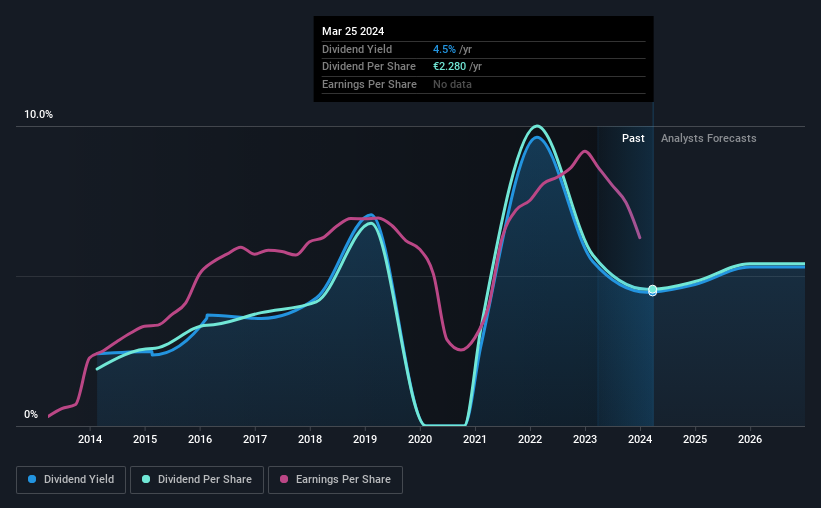Randstad N.V. (AMS:RAND) Is About To Go Ex-Dividend, And It Pays A 4.5% Yield
Randstad N.V. (AMS:RAND) is about to trade ex-dividend in the next couple of days. Typically, the ex-dividend date is one business day before the record date which is the date on which a company determines the shareholders eligible to receive a dividend. The ex-dividend date is an important date to be aware of as any purchase of the stock made on or after this date might mean a late settlement that doesn't show on the record date. Thus, you can purchase Randstad's shares before the 28th of March in order to receive the dividend, which the company will pay on the 4th of April.
The company's next dividend payment will be €2.28 per share, on the back of last year when the company paid a total of €2.28 to shareholders. Based on the last year's worth of payments, Randstad has a trailing yield of 4.5% on the current stock price of €51.02. If you buy this business for its dividend, you should have an idea of whether Randstad's dividend is reliable and sustainable. We need to see whether the dividend is covered by earnings and if it's growing.
Check out our latest analysis for Randstad
Dividends are typically paid out of company income, so if a company pays out more than it earned, its dividend is usually at a higher risk of being cut. Randstad paid out more than half (66%) of its earnings last year, which is a regular payout ratio for most companies. Yet cash flows are even more important than profits for assessing a dividend, so we need to see if the company generated enough cash to pay its distribution. Fortunately, it paid out only 48% of its free cash flow in the past year.
It's encouraging to see that the dividend is covered by both profit and cash flow. This generally suggests the dividend is sustainable, as long as earnings don't drop precipitously.
Click here to see the company's payout ratio, plus analyst estimates of its future dividends.
Have Earnings And Dividends Been Growing?
Stocks with flat earnings can still be attractive dividend payers, but it is important to be more conservative with your approach and demand a greater margin for safety when it comes to dividend sustainability. Investors love dividends, so if earnings fall and the dividend is reduced, expect a stock to be sold off heavily at the same time. With that in mind, we're not enthused to see that Randstad's earnings per share have remained effectively flat over the past five years. Better than seeing them fall off a cliff, for sure, but the best dividend stocks grow their earnings meaningfully over the long run.
Another key way to measure a company's dividend prospects is by measuring its historical rate of dividend growth. Randstad has delivered an average of 9.1% per year annual increase in its dividend, based on the past 10 years of dividend payments.
Final Takeaway
Is Randstad worth buying for its dividend? We're not enthused by the flat earnings per share, although at least the company's payout ratio is within reasonable bounds. Additionally, it paid out a lower percentage of its free cash flow, so at least it generated more cash than it spent on dividends. Overall, it's hard to get excited about Randstad from a dividend perspective.
If you're not too concerned about Randstad's ability to pay dividends, you should still be mindful of some of the other risks that this business faces. Our analysis shows 2 warning signs for Randstad and you should be aware of these before buying any shares.
A common investing mistake is buying the first interesting stock you see. Here you can find a full list of high-yield dividend stocks.
Have feedback on this article? Concerned about the content? Get in touch with us directly. Alternatively, email editorial-team (at) simplywallst.com.
This article by Simply Wall St is general in nature. We provide commentary based on historical data and analyst forecasts only using an unbiased methodology and our articles are not intended to be financial advice. It does not constitute a recommendation to buy or sell any stock, and does not take account of your objectives, or your financial situation. We aim to bring you long-term focused analysis driven by fundamental data. Note that our analysis may not factor in the latest price-sensitive company announcements or qualitative material. Simply Wall St has no position in any stocks mentioned.

 Yahoo Finance
Yahoo Finance 
